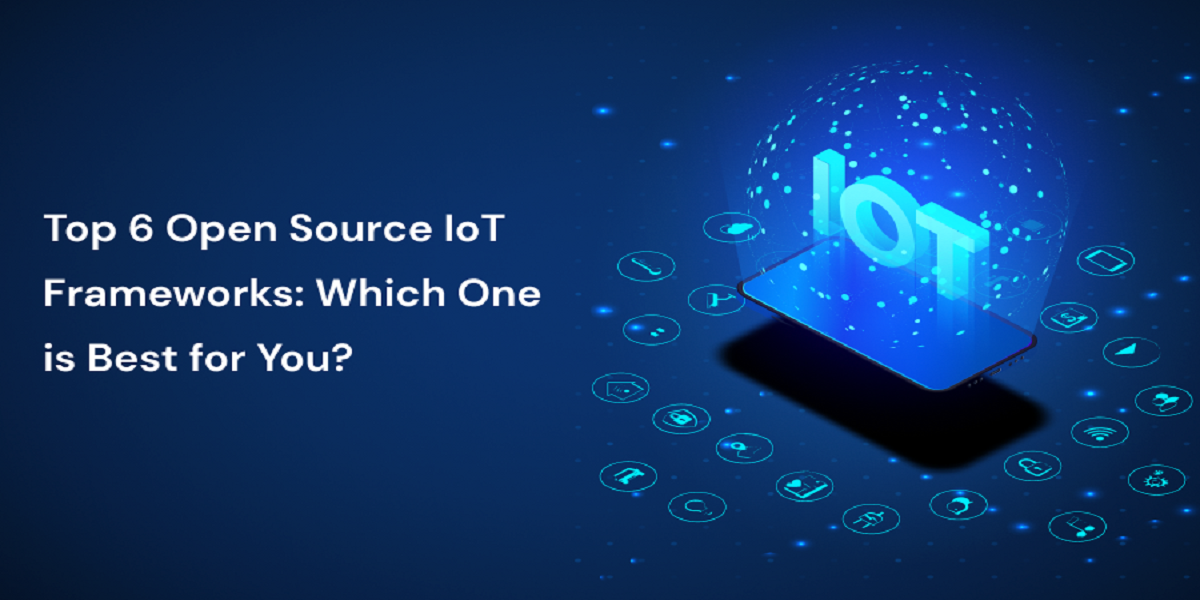
Top 6 Open Source IoT Frameworks: Which One is Best for You?
- By Patrick R
- 08-04-2022
- Technology
Be it homes, offices, hospitals, institutes, or factories, IoT devices are becoming an integral part of our lives. The adaptation is showing no signs of slowing down, which has created a need to build open-source IoT platforms. Such platforms are bound to attract many new users and contributors.
In this quest to have open-source platforms widening the IoT horizons, open-source frameworks will play a crucial role. So let’s first start by understanding what open source IoT frameworks are and what makes them crucial for success.
What is an Open-Source IoT Framework?
IoT devices generate and transmit data among themselves to perform various functions. There needs to be an anchor in such a network of these devices through which the data is collected, processed, and transmitted. That is what an IoT framework does.
IoT open-source framework is an ecosystem that facilitates the collection, storage, and transmission of information. To sum it up in simple terms, an IoT framework ensures seamless communication between a network of IoT devices.
Components of an Open Source IoT Framework
A typical open source IoT framework can be divided into four major components: Hardware Devices, Software Applications, Cloud & Communication platforms, and Cloud Applications. Let’s see the role each of these components plays.
1. Device Hardware
As we saw above, an IoT framework allows IoT devices to interact with each other. This cannot happen without a hardware device. Components such as sensors, controllers, and microcontrollers are the essential hardware components. If you’re working on IoT frameworks, you need to have a fundamental knowledge of these hardware components.
2. Device Software
The hardware components such as controllers need to be programmed to be able to operate them remotely. You’ll need to work with the API and libraries to configure the micro-controllers.
3. Communication and Cloud Platform
The cloud or communication platform is the central part of the IoT ecosystem as it paves the way for all the communication among IoT devices. To set this up, you’ll need to work on integration and cloud technologies.
4. Cloud Application
A cloud application integrates the hardware, software, and cloud platform to maximize the efficacy of an open-source IoT framework. A cloud application is a software that can be kept local or on the cloud.
Top 6 Open Source IoT Frameworks
Now that you’ve got an idea of what an open-source IoT framework is and what it’s made of, let's look at the leading open source IoT frameworks that you could use for your IoT application.
1. KAA
KAA is an enterprise-grade IoT platform, which enables IoT experts to implement advanced-level smart applications. Loaded with features, KAA helps with many challenges you face while implementing an IoT ecosystem. It is known for its speed and scalability.
Kaa follows Portable Microservices architecture and Open APIs. It offers data collection, device management, IoT insightful analytics, and streamlined dashboards. In a nutshell, KAA provides unlimited connected devices with cross-device interoperability and real-time monitoring. It is flexible, fast, scalable, and modern.
Features:
Easy integration between devices
Seamless data transfer between the device/application
Remote monitoring of devices
Connects an unlimited number of devices
Facilitates cross-device interoperability
2. DeviceHive
Distributed under Apache 2.0 license, DeviceHive is a feature-rich framework that is accessible through both versions of cloud - Public and Private. It not only supports mobile native libraries but also supports providers Docker, Kubernetes - alike deployment options.
With DeviceHive, you can execute batch analytics and machine learning algorithms on connected devices.
Features:
Works with Python, Node.js, Java, Android, iOS and other client libraries
Connects to devices with REST API, WebSockets or MQTT protocols
Extensive support for big data analytics
Supports Docker and Kubernetes deployment options
3. Zetta
Zetta was one of the first open source IoT frameworks that allowed non-stop streaming data loads. It has been built around NodeJS REST and flow-based reactive program development.
With tools like Splunk, Zetta supports data visualization tools and machine analytics. It establishes a zero-distributed network through the connection of endpoints, such as Linux or Arduino hacker boards, with platforms like Heroku.
Features:
Integration with data visualization tools
Built on NodeJS
Secure connection between network devices
Simple interface and necessary programming
Can easily integrate with smartphone, device, and cloud apps
4. ThingSpeak
One of the latest IoT frameworks, ThingsSpeak allows you to analyze and visualize the data in MATLAB. Thus, you won’t have to worry about purchasing a license for it. It can work with MathWorks and can facilitate data transmission across multiple channels.
ThingsSpeak seamlessly works with applications such as Arduino, particle photon, electron, etc. You can easily store data in private channels and share in public channels. Although it's a relatively young platform, you get robust community support with ThingsSpeak.
Features:
Real-time data analytics & visualization capabilities
Seamless data sharing from private to public channels
Works with MATLAB for data analysis and visualization
Extensive tools support
5. MACCHINA.IO
Based on JavaScript and C++, MACCHNA.IO is an open source IoT framework that supports a wide range of sensors and connection technologies such as Tinkerforge, bricklets, Xbee, etc. It offers an ideal environment for IoT devices used in home automation, industrial edge computing, IoT gateways, smart sensors, and energy management systems.
On the back of fast development, easy deployment and reduced downtime, MACCHINA.IO has become one the most preferred open source IoT framework among developers.
Features:
Fast & easy application development
Cost-effectiveness
Reduced downtime
Supports wide range of sensors
6. GE Predix
GE Predix is an open source IoT framework that was developed by GE for its internal operations. With time, it has become a popular enterprise framework, especially after the partnership of GE and HPE.
It is a platform as a service (PaaS) software that is based on the concept of cloud foundry. With GE predix, you can do asset management, data collection, device security, real-time predictive analytics, etc.
Features:
Patent-free
Secure, reliable and simple
Connectivity from edge to cloud
Extensive data collection & analysis capabilities
Conclusion: How to Choose the Right Open Source IoT Framework?
The goal of an IoT framework is to facilitate seamless data collection, storage and distribution. The frameworks we just discussed do that greatly and choosing any might make sense at first glance. However, the difference lies in the details as they house many features, work on different technologies and have different use cases.
To conclude the decision making process, we’d suggest you take the below criteria into consideration:
End use / application
Price
Data analysis & visualization capabilities
Development technology
Supported technologies (MATLAB, Arduino, MathWorks, etc.)
Tools & community support
Data security
Thus, you don’t need to go for the “best” or most popular IoT framework. All you need to do is understand your requirements and find the ‘right’ one. Simple, isn’t it?
Recent blog

Crafting Eye-Catching Instagram Reels In Just 9 Easy Steps
Social Media | 25-04-2024.png)
Boost Sales and Conversions with Shopify's New AI-Powered Semantic Search
E-commerce | 24-04-2024




